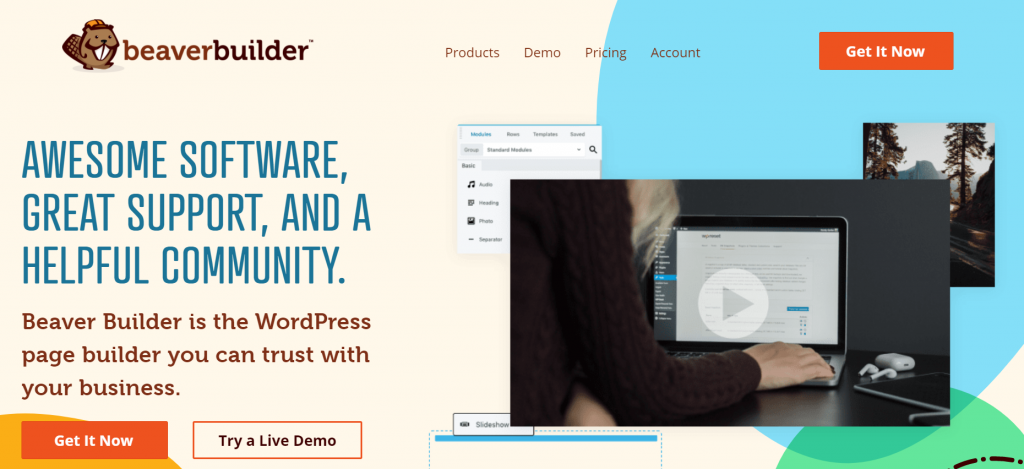Contents
Beaver Builder Vs Divi
Using a page builder is an excellent choice if you don’t have a lot of design or development experience. By providing so much more features than the default WordPress page editor, they help you to create beautiful looking pages with ease.
Website-building companies have used a variety of tools to simplify building pages for themselves as well as their clients. This is a comparison between two well-known page builders- Beaver Builder vs Divi so you can decide which one best suits your needs.

Beaver Builder
The Beaver Builder plugin for WordPress gives you all the tools you need to create a fast and beautiful website. Free templates are available that can be customized with text, photos, videos, etc. Alternatively, you can create your own layout by adding columns and filling them with any content module you like. Dexter also has full-width, column-based layouts you can use. As well as supporting short codes, it works with any WordPress theme and can also be used with other plugins. It has a lot of customization options and is easy to learn. Additionally, Beaver Builder offers the following features:
- The modules include row separators, photo editing tools, text editors, audio and video players, etc.
- Layouts with 100% responsiveness
- Row backgrounds can be rendered as photos, colors, or videos
- Pages with fast loading layouts
- In the near future, undo/redo will be available
Divi
It’s another stunning drag and drop website builder to use with the Divi WordPress plugin. New features and improvements have been added since it was updated recently. It doesn’t require a text box, and the editor is intuitive enough to let you type anywhere on the page. Divi contains more than twenty pre-made layout templates and other customized layouts can be created (even with a CTA) as well as imported and exported to different websites. Additionally, Divi allows you to edit a page right away. Divi also includes:
- Everything can be customized
- Easy to organize. Everything will fit if you add a row and a column
- Global elements – allows you to sync headers, footers, etc. across multiple pages
- It consists of a number of modules, including testimonials, social media, sliders, tabs, videos, and sidebars.
The Beaver Builder and Divi components we’ve implemented into our toolbox have made a positive impact on us and our clients. The only notable difference between them is Beaver Builder leaves clean code behind, while Divi doesn’t. There really is no way to go wrong with either of them, as long as leaving clean code behind isn’t an issue.
Frontend Interface
Beaver Builder and Divi are both visual frontend editors; however, their approaches differ. You’ll do most of your work in Beaver Builder’s sidebar, while Divi uses floating options.
Beaver Builder Frontend Interface
Content modules and related settings are displayed in Beaver Builder’s sidebar.
Beaver Builder frontend editor
In addition, the sidebar can be positioned either to the left or right of the screen, which is a unique feature that makes the workflow more efficient.
Beaver Builder now supports in-line editing alongside Divi, providing the ability to edit text in any module (just like in a Word document). Additionally, you can create new columns or rows in Beaver Builder by dragging and dropping the content modules, but you need to do it manually in Divi.
I find the Beaver Builder editor to be fast and easy to use, I can customize all parts of the layout in the editor. Learning Beaver Builder will take time, but once you get past the learning curve, you’ll have no trouble.
Divi Builder Interface
As Beaver Builder comes with a backend editing option, you won’t be missing it if you decide to go with Divi.
As for the Divi editing interface, there is no sidebar, and each option is displayed as a pop-up on the preview of the site. Divi lets you view the full-width preview of your site without having to switch the sidebar on and off every time.
Divi builder content modules
Click the + icon next to the rows and columns to add new content modules. Drag that element onto the rows and columns. For making quick changes to the page, there is also the option of using the wireframe view.
Ease of use
A page builder is all about ease of use since that’s what makes it so popular.
They allow users to build a fully functional website without having to know any coding. As a result, developers now use page builders in addition to HTML and CSS to build websites faster.
Beaver Builder Ease of Use
Following the installation and activation of Beaver Builder, you will be welcomed with an onboarding process, which gives you immediate access to all the information you need.
Modules can be dragged and dropped to begin editing, and then customized accordingly. The ‘+’ icon at the top of the page lets you add modules to any page.
This Beaver Builder sidebar shows all the content modules, rows, and templates
You can manage any multisite installs using Beaver Builder’s network-wide control panel by managing the changes from one location.
The Beaver Builder theme is user-friendly, has a simple design, and all the editing features are well-placed.
It’s worth noting that Beaver Builder doesn’t offer a dedicated feature for editing full-width templates, so if your theme doesn’t support it, you won’t be able to design 100% full-width pages.
Divi Builder Ease of Use
You can start Divi builder by going to any page or post and selecting Use Divi Builder. Following that, you’ll be able to build a page from scratch, choose a pre-built layout, or clone an existing one.
Divi visual builder
A section must be set first, followed by a row, and then the module. You will have no difficulty editing your website once you learn the editor, but it can be difficult at first.
A Divi section, a row, and a module
Three different ‘+’ icons can be seen above – the blue one for sections, the green one for rows, and the black one for modules.
If you work with long complex pages, Divi Builder will be extremely intuitive, as it’s easy to convert long complicated pages to wireframes or backend views.
Pros and Cons Beaver Builder
Pros
- Easy to use and simple
- No restrictions on the use of this plugin
- No problems with shortcodes or code cleaning
- Code editing with live preview in JavaScript
- Working with him is extremely fast
- For agencies, there is the option of white labeling
- The ability to manage multiple sites
Cons
- The Beaver Builder theme can be quite expensive, especially if you want to use it
- Templates that are limited in number
Pros
- The Divi visual builder is extremely powerful
- With the lifetime plan, you’ll get good value for your money
- Prebuilt layouts designed by professionals in a huge library
- A wireframe view of the backend
- Split testing and lead generation tools are among the marketing features built into the platform
Cons
- The approach is based on shortcodes, so there is no clean code (unless you plan to change your page builder).
- Occasionally slow due to a lack of server resources
(You can download a demo version instead)
Pricing — Divi vs Beaver Builder
There is no limit to the number of sites you can create using Beaver Builder vs Divi due to the pricing of both page builders.
Beaver Page Builder Pricing
- With a limited set of modules, it’s forever free
- License for unlimited sites at $99 standard plan
- At $199, the Pro plan includes everything in the Standard plan plus Beaver Builder and multisite capabilities
- Plan for agencies at $399 with white labeling option plus everything in Pro plan
Divi Pricing
- An annual membership plan at $89 provides you with access to all Elegant Themes products (Divi, Extra, Bloom, Monarch, etc. ), hundreds of website packs, premium support, and unlimited web space.
- Afterwards, you will not be charged yearly fees as long as you have a lifetime access plan.
- When you compare the starting plans of Beaver Builder and Divi, Beaver Builder is more expensive. In the yearly access plan of Divi Builder, you will receive the Divi theme along with Beaver Builder.
You can therefore try both page builders before making a decision and choose the one that is right for you. Additionally, both page builders offer 30-day full refunds with no questions asked, so if you’re not happy, you can get your money back.
Quick Links
Final Thoughts — Beaver Builder vs Divi
In comparison to Divi Builder, Beaver Builder is ideal for bloggers, small business owners, SEOs, developers, and anyone else wanting to build a website without coding.
With Digi, beginners can easily design their own website since the software offers hundreds of pre-designed templates. Divi will make a great investment for freelancers or web design agencies since it doesn’t require you to pay recurring fees and you can use their products for unlimited websites.
There are many robust page builder tools for WordPress, including Beaver Builder. Beaver Builder provides all the basic features and customizability options. Additionally, the lite version is a good option to try before you upgrade.
It’s hard to go wrong with either one of these products, so it’s more a matter of what you like. With the comparative analysis provided above, we hope we were able to help you better understand which builder is most suitable for your WordPress website.

